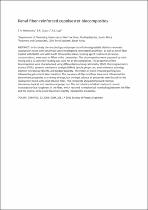JavaScript is disabled for your browser. Some features of this site may not work without it.
- ResearchSpace
- →
- Research Publications/Outputs
- →
- Journal Articles
- →
- View Item
| dc.contributor.author |
Mokhothu, Thabang H

|
|
| dc.contributor.author |
Guduri, BR

|
|
| dc.contributor.author |
Luyt, AS

|
|
| dc.date.accessioned | 2012-04-11T10:58:32Z | |
| dc.date.available | 2012-04-11T10:58:32Z | |
| dc.date.issued | 2011-12 | |
| dc.identifier.citation | Mokhothu, T.H., Guduri, B.R. and Luyt, A.S. 2011. Kenaf fiber-reinforced copolyester biocomposites. Polymer Composites, vol. 32(12), pp 2001-2009 | en_US |
| dc.identifier.issn | 0272-8397 | |
| dc.identifier.uri | http://onlinelibrary.wiley.com/doi/10.1002/pc.21233/full | |
| dc.identifier.uri | http://hdl.handle.net/10204/5733 | |
| dc.description | Copyright: 2011 Wiley. This is an ABSTRACT ONLY. | en_US |
| dc.description.abstract | In this study the morphology and properties of a biodegradable aliphatic–aromatic copolyester mixed with kenaf fiber were investigated. Untreated kenaf fiber, as well as kenaf fiber treated with NaOH, and with NaOH followed by silane coupling agent treatment at various concentrations, were used as fillers in the composites. The biocomposites were prepared by melt-mixing and a 10 wt% fiber loading was used for all the composites. The properties of the biocomposites were characterized using differential scanning calorimetry (DSC), thermogravimetric analysis (TGA), dynamic mechanical analysis (DMA), tensile properties, environmental scanning electron microscopy (ESEM), and biodegradability. The extent of silane initiated grafting was followed by gel content determination. The presence of fiber and fiber treatment influenced the determined properties in a variety of ways, but the best balance of properties were found for the copolyester mixed with alkali-treated fiber. This composite showed improved thermal, thermomechanical, and mechanical properties. The introduction of alkali treatment caused increased surface roughness in the fiber, which resulted in mechanical interlocking between the filler and the matrix, while silane treatment slightly reduced the properties. | en_US |
| dc.language.iso | en | en_US |
| dc.publisher | Wiley | en_US |
| dc.relation.ispartofseries | Workflow;7931 | |
| dc.subject | Bio-composites | en_US |
| dc.subject | Aliphatic-aromatic co-polyester | en_US |
| dc.subject | Kenaf fiber | en_US |
| dc.subject | Thermal properties | en_US |
| dc.subject | Tensile properties | en_US |
| dc.subject | SEM | en_US |
| dc.subject | Biodegradability properties | en_US |
| dc.title | Kenaf fiber-reinforced copolyester biocomposites | en_US |
| dc.type | Article | en_US |
| dc.identifier.apacitation | Mokhothu, T. H., Guduri, B., & Luyt, A. (2011). Kenaf fiber-reinforced copolyester biocomposites. http://hdl.handle.net/10204/5733 | en_ZA |
| dc.identifier.chicagocitation | Mokhothu, Thabang H, BR Guduri, and AS Luyt "Kenaf fiber-reinforced copolyester biocomposites." (2011) http://hdl.handle.net/10204/5733 | en_ZA |
| dc.identifier.vancouvercitation | Mokhothu TH, Guduri B, Luyt A. Kenaf fiber-reinforced copolyester biocomposites. 2011; http://hdl.handle.net/10204/5733. | en_ZA |
| dc.identifier.ris | TY - Article AU - Mokhothu, Thabang H AU - Guduri, BR AU - Luyt, AS AB - In this study the morphology and properties of a biodegradable aliphatic–aromatic copolyester mixed with kenaf fiber were investigated. Untreated kenaf fiber, as well as kenaf fiber treated with NaOH, and with NaOH followed by silane coupling agent treatment at various concentrations, were used as fillers in the composites. The biocomposites were prepared by melt-mixing and a 10 wt% fiber loading was used for all the composites. The properties of the biocomposites were characterized using differential scanning calorimetry (DSC), thermogravimetric analysis (TGA), dynamic mechanical analysis (DMA), tensile properties, environmental scanning electron microscopy (ESEM), and biodegradability. The extent of silane initiated grafting was followed by gel content determination. The presence of fiber and fiber treatment influenced the determined properties in a variety of ways, but the best balance of properties were found for the copolyester mixed with alkali-treated fiber. This composite showed improved thermal, thermomechanical, and mechanical properties. The introduction of alkali treatment caused increased surface roughness in the fiber, which resulted in mechanical interlocking between the filler and the matrix, while silane treatment slightly reduced the properties. DA - 2011-12 DB - ResearchSpace DP - CSIR KW - Bio-composites KW - Aliphatic-aromatic co-polyester KW - Kenaf fiber KW - Thermal properties KW - Tensile properties KW - SEM KW - Biodegradability properties LK - https://researchspace.csir.co.za PY - 2011 SM - 0272-8397 T1 - Kenaf fiber-reinforced copolyester biocomposites TI - Kenaf fiber-reinforced copolyester biocomposites UR - http://hdl.handle.net/10204/5733 ER - | en_ZA |






